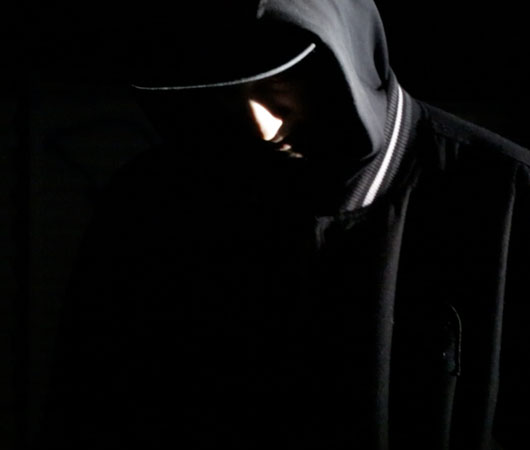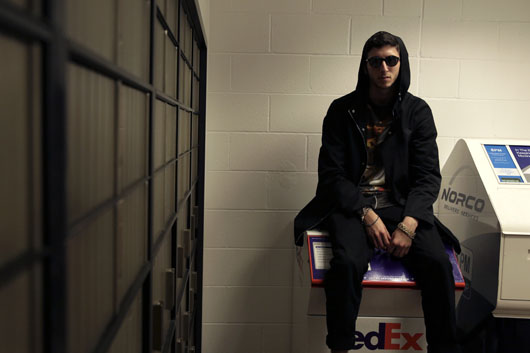Deep Inside: Shlohmo ‘Laid Out’ EP
Throughout the ever-ascending career of Henry Laufer (a.k.a. Shlohmo), the California producer’s beats have seen […]

Deep Inside: Shlohmo ‘Laid Out’ EP
Throughout the ever-ascending career of Henry Laufer (a.k.a. Shlohmo), the California producer’s beats have seen […]

Throughout the ever-ascending career of Henry Laufer (a.k.a. Shlohmo), the California producer’s beats have seen a consistent progression of form. From the Shlohmoshun mini-LP and other earlier works to 2011’s Places EP and Bad Vibes album, the rough, stuttering head-nodders that defined Shlohmo’s initial outings have given way to beats that incorporate bits of live instrumentation while coming across with more of a soul-burned singe. The transformation continued on last year’s Vacation EP, which found Laufer wrapping his glowing textures around a more bass-minded core, infusing the efforts with the skittering hats, tuned snares, and reworked vocals of R&B-informed trap and post-dubstep. Still, despite all these stylistic twists and turns, the character of Laufer’s productions has largely remained unaltered, as he continues to display a natural comfort with contemplative moods and introspective, even somber musical themes. Laid Out, his latest EP, stays true to this pattern, bringing with it a new sonic twist while once again finding Laufer decidedly pensive and subdued.
“I was 18 and 19 [years old] when I was making Shlomoshun. I didn’t know what the fuck I was doing,” says Laufer of his 2010 mini-LP, offering one possible reason why his aesthetic has changed so much over the past few years. Without a doubt, Laid Out is the sharpest of Laufer’s releases, particularly in terms of its rhythmic palette, which appears entirely stripped of the pot-and-pan clunks and found-sound clicks and crackles that many had come to associate with Shlohmo and the beat scene as a whole. Taking the drum programming and stylistic cues of Vacation to the next logical step, the backbone of Laid Out has more in common with modern hip-hop and trap than, say, Dilla or Flying Lotus. “I wanted the drums to be really stark and very blunt, mostly unaffected drum-machine sounds,” says Laufer. Indeed, the EP’s skittering hats, snares, and kicks are left relatively dry and out in the open. The change was intentional, as Laufer explains that moving beyond the found-sound exploration of his earlier productions was very much a conscious decision. “When Bad Vibes was getting made,” he says, “the Foley room kind of sounds really helped my ideas come across. Now, I still feel like I’m after the same feeling [as before], but the times have changed and this type of stark drums represents that feeling better.”‘
As it turns out, the rhythms aren’t the only element that Laufer strips back to more efficient forms on Laid Out. Almost every other aspect of his production has been streamlined; for instance, monophonic synth leads jump to the forefront while calm basslines and soft-synth chords exist in plain sight. Again, this was a calculated move on Laufer’s part. “Bad Vibes was really maximal for me. Every track was 30 layers deep in shit; if a song didn’t sound right, I’d just keep adding to it. On Laid Out, I wanted to boil things down,” he says before adding, “[I wanted] to make it as simple as I possibly could while still having the same intensity and the same vibe [as my other works].” Interestingly enough, this effort seems to have led the EP to sound much more “electronic” than any of the previous Shlohmo records. With the exception of the occasional guitar line and How to Dress Well‘s vocal, which features on the opening cut, Shlohmo’s past profeciency for real-world sounds and acoustic details has been traded in for sounds with a more direct impact. Laufer admits that most of the record was made inside his laptop; for better or worse, that comes through in the EP’s sharp, digital sheen.

Laid Out opens with “Don’t Say No,” a particularly downtrodden cut on which the soaring falsetto of How to Dress Well (a.k.a. Tom Krell) is set amongst a thin bed of fuzzy synths, FX-washed guitar, and a steady 3/4 beat. It could be said that “Don’t Say No” is the least “boiled down” of the record’s offerings, and—perhaps because of this—in many ways is one of its most compelling cuts. The stark drums and solemn atmosphere suit Krell’s delivery well, and the track’s dynamics follow a pleasantly unexpected path, swelling in unforeseen corners while patiently building up to an engrossing culmination of distorted synth lines, far-off melodies, and wide pads that move at a glacial pace. In a way, placing Laid Out‘s most involved production at the beginning of its run does the EP something of a disservice, as more often than not, the subsequent tracks feel vacant in ways that “Don’t Say No” did not.
Still, Shlohmo does hit on a number of interesting ideas on the EP’s remaining efforts. The influence of various UK production outfits shines through “Out of Hand,” which utilizes a skittering, Mount Kimbie-style beat—albeit one with more robust drum tones than one is likely to hear coming from across the pond. The track also incorporates a touch of spooky G-funk, thanks to a warbly, ever-present synth lead that rings out for about half the tune in an unexpectedly high register. It’s a strange mixture on paper, but Laufer manages to make the pieces fit together. The following cut, “Later,” hews closer to the exact formula everyone expects Shlohmo to be using at this point in his career—a mix of slow and stoney R&B with trap-informed snares and hat rolls. Nevertheless, despite its predictable shape, it’s hard to argue with the song’s poignant chords and irresistibly catchy melodies, particularly the alternating layers of distorted vocals, which sound as if they have been run through a virtual guitar amp or overdriven tape emulator.
“Later” may be slow by most traditional “dance music” standards, but listening to the track, one can’t help but hear the trajectory of Laufer’s productions moving gradually closer to the dancefloor and live arena. It’s not an overt change, as Laufer hasn’t begun turning out gluttonous, Baauer-style trap anthems. Yet as his career has progressed, Shlohmo has become an increasingly in-demand live act; as such, he’s expected to bring a party, and so his work has taken small—but by no means unwarranted—steps towards sounding appropriate in that setting. Stark, dry drums punch through club systems, and straightforward synth lines undoubtedly cut through a boisterous crowd more effectively than swirls of murky pads and haze-filled atmospherics. Laufer admits that he does feel some pressure to settle the differences between the live-performance Shlohmo and his work as a producer, but he asserts he hasn’t yet made a conscious effort to do so. “I don’t think I’ve changed my music specifically to accommodate a dancefloor,” he explains, “but I think it has sort of happened by chance,” adding, “You don’t go to a party wanting to listen to Bad Vibes.”

Even so, Laid Out is hardly an attempt to strike a chord with any fleeting dancefloor trend. At its core, the record is true to what Shlohmo has been known for throughout his career—moody, contemplative beats. Laufer finds it hard to explain, but after a few years of pushing his brand of “slow” music, it’s nonetheless more acceptable than ever before. “There wasn’t the space for this kind of stuff [in a live setting] even three years ago,” explains Laufer. “Back then, I was getting bottles thrown at me for playing slow shit.” With a headlining North American tour set for the months ahead, and a lengthy list of live dates behind him, it’s apparent that the scales have tipped in his direction.
At the same time, Laid Out is not an effort without its drawbacks. As stated before, the record has a good deal of continuity with Shlohmo’s past efforts, and part of that includes his bad habits. Over the course of his discography, Laufer has struggled to recognize when an idea has been sufficiently explored. For instance, the Places EP offered four tracks, yet its title track was the only real takeaway. Bad Vibes felt encumbered by too many similar productions. Similarly, Laid Out would have benefitted from a truncated tracklist. Within the context of the EP, “Put It” feels like a less remarkable product of the same formula which yields “Later,” and the closing “Without” comes across like a half-hearted attempt to reach back to an earlier Shlohmo era, though its aimless six-minute run only succeeds in demonstrating that Laufer has moved on. Despite his stated goal to distill the elements of his work into more efficient building blocks, Laufer fails to apply that same sensibility to the way these ideas are being presented. On songs like “Don’t Say No” and “Later,” he sounds confident in his evolution as a producer, but the EP’s extraneous efforts call that same confidence into question and ultimately lessen the record’s impact. Make no mistake, Laid Out has its moments and certainly isn’t a misstep, but it could be called a sidestep; as such, it’s bound to raise questions about whether Shlohmo is capable of one day transcending the (admittedly high) standard set by his initial ouput.

